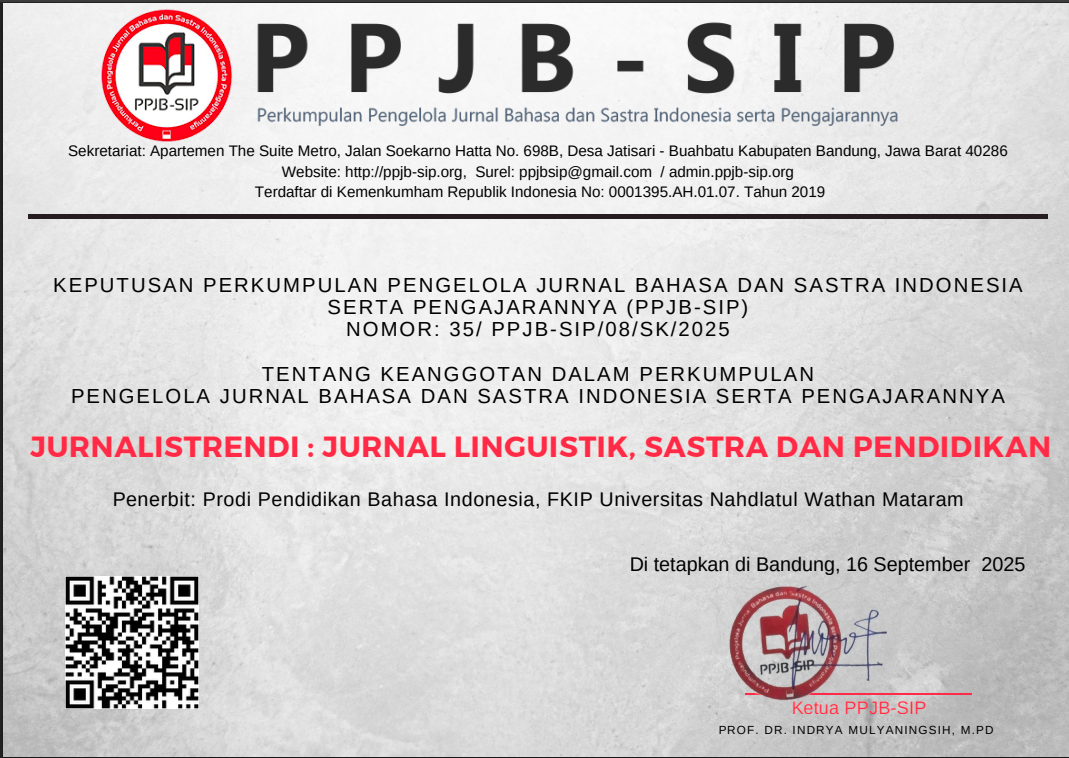Persepsi Warganet Terhadap Konten Bermuatan Kebanggaan Berbahasa Indonesia dalam Kanal Youtube Nihongo Mantappu
Abstract
This research is motivated by the existence of YouTube content containing pride in Indonesian on the Nihongo Mantappu YouTube channel. This study aims to look at the perception of netizens on Nihongo Mantappu's YouTube content. To achieve this goal, this research uses descriptive qualitative methods with sociolinguistic and syntactic theoretical approaches. The data of this research are in the form of written comments from netizens which are classified into three forms, namely supporting prepositions, refuting prepositions, and ambiguous prepositions, according to the theory of responders' assumptions from Saifullah (2019). The netizens' written comments were obtained from five videos containing pride in the Indonesian language on the Nihongo Mantappu YouTube channel. Data were collected by note-taking technique. The data were analyzed using the data analysis method model of Miles and Huberman (1994). The results of this study indicate that netizens have a positive perception of Nihongo Mantappu's YouTube content. This is indicated by the number of netizen comments which are included in the preposition to support Nihongo Mantappu's YouTube channel. The number of positive comments/support for YouTube content can be one of the external factors in the sustainability of the YouTube channel.
Downloads
References
Balakrishnan, J., & Griffiths, M. D. (2017). Social media addiction: What is the role of content in YouTube? Journal of Behavioral Addictions, 6(3), 364–377. https://doi.org/10.1556/2006.6.2017.058.
Bareket-Bojmel, L., Moran, S., & Shahar, G. (2016). Strategic self-presentation on Facebook: Personal motives and audience response to online behavior. Computers in Human Behavior, 55, 788–795.
Bourhis, R. Y. (1983). Language attitudes and self-reports of french-english language usage in quebec. Journal of Multilingual and Multicultural Development, 4(2–3), 163–179. https://doi.org/10.1080/01434632.1983.9994109.
Bourhis, R. Y., Giles, H., & Tajfel, H. (1973). Language as a determinant of Welsh identity. European Journal of Social Psychology, 3(4), 447–460. https://doi.org/10.1002/ejsp.2420030407.
Callan, V. J., & Gallois, C. (1982). Language Attitudes of Italo‐Australian and Greek‐Australian Bilinguals. International Journal of Psychology, 17(1–4), 345–358. https://doi.org/10.1080/00207598208247450.
Cargile, A. C., Giles, H., Ryan, E. B., & Bradac, J. J. (1994). Language attitudes as a social process: A conceptual model and new directions. Language and Communication, 14(3), 211–236. https://doi.org/10.1016/0271-5309(94)90001-9.
Chung, J. E. (2015). Antismoking campaign videos on YouTube and audience response: Application of social media assessment metrics. Computers in Human Behavior, 51, 114–121.
Cunningham, S., & Craig, D. (2017). Being ‘really real’ on YouTube: authenticity, community and brand culture in social media entertainment. Media International Australia, 164(1), 71–81. https://doi.org/10.1177/1329878X17709098.
Dragojevic, M., & Giles, H. (2016). I Don’t Like You Because You’re Hard to Understand: The Role of Processing Fluency in the Language Attitudes Process. Human Communication Research, 42, 396–420. https://doi.org/10.1111/hcre.12079.
Feely, A. J., & Harzing, A. W. (2003). Language management in multinational companies. Cross Cultural Management: An International Journal, 10(2), 37–52. https://doi.org/10.1108/13527600310797586.
Fernández-Carballo, M. V. (2021). University Students’ Attitudes towards the Use of YouTube in the EFL Classroom. How, 28(2), 141–158. https://doi.org/10.19183/how.28.2.624.
García, O., Peltz, R., & Schiffman, H. F. (2006). Language Loyalty, Continuity and Change. Clevedon: Multilingual Matters LTD.
Giles, H., Bourhis, R. Y., & Taylor, D. M. (1977). Towards a Theory of Language in Ethnic Group Relations. In H. Giles (Ed.), Language, Ethnicity and Intergroup Relations (pp. 307–348). London: Academic Press.
Gumiar, A. (2022). Sikap Bahasa Warganet Terhadap Konten Digital Berbahasa Dayak Ngaju. SINAR BAHTERA I, 47–56. https://doi.org/https://doi.org/10.51817/sb.vi.81.
Hosseinmardi, H., Ghasemian, A., Clauset, A., Mobius, M., Rothschild, D. M., & Watts, D. J. (2021). Examining the consumption of radical content on YouTube. Proceedings of the National Academy of Sciences of the United States of America, 118(32), 1–8. https://doi.org/10.1073/pnas.2101967118.
Lee, C., & Chau, D. (2017). Language as pride, love, and hate: Archiving emotions through multilingual Instagram hashtags. Discourse, Context and Media, 21–29. https://doi.org/10.1016/j.dcm.2017.06.002.
Li, H. O. Y., Bailey, A., Huynh, D., & Chan, J. (2020). YouTube as a source of information on COVID-19: A pandemic of misinformation? BMJ Global Health, 5, 1–6. https://doi.org/10.1136/bmjgh-2020-002604.
Marranci, G. (2008). The Anthropology of Islam. Oxford: Berg. https://doi.org/10.35632/ajis.v25i4.1440.
Mesthrie, R., Swann, J., Deumert, A., & Leap, W. L. (2009). Introducing Sociolinguistics (2nd ed.). Edinburgh: Edinburgh University Press.
Miles, M. B., & Huberman, A. M. (1994). Qualitative Data Analysis: An Expanded Sourcebook (2nd ed.). London: SAGE Publications, Inc.
Moghavvemi, S., Sulaiman, A., Jaafar, N. I., & Kasem, N. (2018). Social media as a complementary learning tool for teaching and learning: The case of youtube. International Journal of Management Education, 16(1), 37–42. https://doi.org/10.1016/j.ijme.2017.12.001.
Ozsoy-Unubol, T., & Alanbay-Yagci, E. (2021). YouTube as a source of information on fibromyalgia. International Journal of Rheumatic Diseases, 24(2), 197–202. https://doi.org/10.1111/1756-185X.14043.
Pires, F., Masanet, M. J., & Scolari, C. A. (2019). What are teens doing with YouTube? Practices, uses and metaphors of the most popular audio-visual platform. Information Communication and Society, 24(9), 1–17. https://doi.org/10.1080/1369118X.2019.1672766.
Saidat, A. M. (2010). Language Attitude : the Case of Jordan Language Attitude : the Case of Jordan. International Journal of Academic Research, 2(6), 235–243.
Saifullah, A. R. (2019). Semiotik dan Kajian Wacana Interaktif di Internet (D. Sudana (ed.); 1st ed.). UPI Press.
Szmuda, T., Özdemir, C., Fedorow, K., Ali, S., & Słoniewski, P. (2021). YouTube as a source of information for narcolepsy: A content-quality and optimization analysis. Journal of Sleep Research, 30(2), 1–7. https://doi.org/10.1111/jsr.13053
Tarno, C. A., & Iswanto. (2019). Sintaksis Bahasa Indonesia (A. S. Hamidin (ed.); 1st ed.). Bandung: Manggu Makmur Tanjung Lestari.


.jpg)





